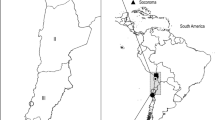Abstract
Suttonella ornithocola, a bacterium in the Cardiobacteriaceae family, is postulated to act as a pathogen targeting the respiratory tract of wild birds in the tit families (Paridae and Aegithalidae). This organism has fastidious culture requirements, which might lead to missed detection; thus, a nested PCR targeting the 16S rRNA gene was designed to provide an additional detection tool. DNA was extracted from combined lung and trachea samples from 114 birds in the Paridae and five in the Aegithalidae. These wild birds were found dead across England and Wales, 2005–2012 inclusive, and examined post-mortem. The PCR detected S. ornithocola in 15 birds from the Paridae family only: 11 blue tits (Cyanistes caeruleus), three great tits (Parus major) and one coal tit (Periparus ater). Derived sequences of the 16S rRNA gene had 100% identity to S. ornithocola from previous studies. Positive cases had a widespread geographical distribution across the study period with recurrent spring seasonality, consistent with an endemic infection. Incident history and pathological findings indicated that S. ornithocola infection was likely to be a significant contributory factor to the deaths of at least two birds (from two sites), was of equivocal significance in four birds (from four sites) and was an incidental finding in nine birds (from eight sites). Nested PCR detected S. ornithocola in ten birds for which microbiological examination of the lung was culture-negative for the bacterium. A combination of molecular, microbiological and histopathological examinations is recommended to further investigate the epidemiology and significance of S. ornithocola infection.

Similar content being viewed by others
References
Beckmann KM, Borel N, Pocknell AM, Dagleish MP, Sachse A, John SK, Popischil A, Cunningham AA, Lawson B, John SK (2014) Chlamydiosis in British garden birds (2005-2011): retrospective diagnosis and Chlamydia psittaci genotype determination. EcoHealth 11(4):544–563. doi:10.1007/s10393-014-0951-x
Benson DA, Karsch-Mizrachi I, Clark K, Lipman DJ, Ostell J, Sayers EW (2012) GenBank. Nucleic Acids Res 40(Database issue):D48–D53
Foster G, Malnick H, Lawson PA, Kirkwood J, Macgregor SK, Collins MD (2005) Suttonella ornithocola sp. nov., from birds of the tit families, and emended description of the genus Suttonella. Int J Syst Evol Microbiol 55:2269–2272. doi:10.1099/ijs.0.63681-0
Kearse M, Moir R, Wilson A, Stones-Havas S, Cheung M, Sturrock S, Buxton S, Cooper A, Markowitz S, Duran C, Thierer T, Ashton B, Mentjies P, Drummond A (2012) Geneious basic: an integrated and extendable desktop software platform for the organization and analysis of sequence data. Bioinformatics 28(12):1647–1649. doi:10.1093/bioinformatics/bts199
Kirkwood JK, Macgregor SK, Malnick H, Foster G (2006) Unusual mortality incidents in tit species (family Paridae) associated with the novel bacterium Suttonella ornithocola. Vet Rec 158(6):203–205
Lawson B, Malnick H, Pennycott TW, Macgregor SK, John SK, Duncan G, Hughes LA, Chantrey J, Cunningham AA (2011) Acute necrotising pneumonitis associated with Suttonella ornithocola infection in tits (Paridae). Vet J 188(1):96–100. doi:10.1016/j.tvjl.2010.03.010
Lawson B, Robinson RA, Colvile KM, Peck KM, Chantrey J, Pennycott TW, Simpson VR, Toms MP, Cunningham AA (2012a) The emergence and spread of finch trichomonosis in the British Isles. Phil Trans Roy Soc B 367:2852–2863. doi:10.1098/rstb.2012.0130
Lawson B, Lachish S, Colvile KM, Durrant C, Peck KM, Toms MP, Sheldon BC, Cunningham AA (2012b) Emergence of a novel avian pox disease in British tit species. PLoS One 7(11):e40176. doi:10.1371/journal.pone.0040176
Lawson B, de Pinna E, Horton RA, Macgregor SK, John SK, Chantrey J, Duff JP, Kirkwood JK, Simpson VR, Robinson RA, Wain J, Cunningham AA (2014) Epidemiological evidence that garden birds are a source of human salmonellosis in England and Wales. PLoS One 9(2):e88968. doi:10.1371/journal.pone.0088968
Robinson RA, Lawson B, Toms MP, Peck KM, Kirkwood JK, Chantrey J, Clatworthy IR, Evans AD, Hughes LA, Hutchinson OC, John SK, Pennycott TW, Perkins MW, Rowley PS, Simpson VR, Tyler KM, Cunningham AA (2010) Emerging infectious disease leads to rapid population declines of common British birds. PLoS One 58:e12215. doi:10.1371/journal.pone.0012215
Acknowledgements
We thank the BTO Garden BirdWatch participants and the general public for reporting and submitting dead garden birds for post-mortem examination; Dr. H Malnick from Public Health England for assistance with primer design; Dr. K. M. Peck from the Royal Society for the Protection of Birds and Mr. M. Toms from the British Trust for Ornithology, for collation of avian mortality incident reports; Katie Beckmann and Ricardo Castro Cesar de Sa for their assistance with the pathological investigations and Ann Pocknell from Finn Pathologists for the histopathological examination of one case.
This study received financial support from the following organisations: Birdcare Standards Association (http://www.birdcare.org.uk); the British Veterinary Association Animal Welfare Foundation (http://www.bva-awf.org.uk); CJ Wildbird Foods (http://www.birdfood.co.uk); (Cranswick Pet Products (http://www.cranswickpetproducts.co.uk/); Defra (http://www.defra.gov.uk) and the Welsh Government through the Animal Plant and Health Agency’s Diseases of Wildlife Scheme Scanning Surveillance Programme (Project ED 1600) within their Scanning Surveillance Programme and project WC1027 from the Strategic Evidence Fund); Esmée Fairbairn Foundation (http://esmeefairbairn.org.uk/); Gardman Ltd. (http://www.gardman.co.uk/), the RSPB (http://www.rspb.org.uk/) and the Universities Federation for Animal Welfare (http://www.ufaw.org.uk).
Author information
Authors and Affiliations
Corresponding author
Rights and permissions
About this article
Cite this article
Peniche, G., Fernandez, J.RR., Durrant, C. et al. Nested PCR for Suttonella ornithocola reveals widespread infection in British Paridae species. Eur J Wildl Res 63, 50 (2017). https://doi.org/10.1007/s10344-017-1105-6
Received:
Revised:
Accepted:
Published:
DOI: https://doi.org/10.1007/s10344-017-1105-6




